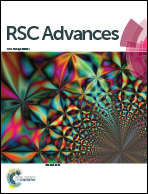Silver-modified porous polystyrene sulfonate derived from Pickering high internal phase emulsions for capturing lithium-ion
Abstract
Adsorption separation based on porous polystyrene sulfonate is an important method of extracting lithium ion (Li+). In this work, silver-modified porous polystyrene sulfonate (PHIPEs-SS-Ag) derived from Pickering high internal phase emulsions was fabricated for the selective binding of Li+. PHIPEs-SS-Ag possessed porous polymer matrix, sufficient sulfonic acid functional groups, and uniformly immobilized silver particles, which were beneficial for improving mass transfer, binding amount and antifouling performance. In batch mode experiments, the adsorption capacity reached a maximum value (i.e. 14.09 mg g−1) under alkaline conditions, and the adsorption mechanism between PHIPEs-SS-Ag and Li+ was electrostatic attraction. PHIPEs-SS-Ag exhibited fast binding kinetics at 25 °C (i.e. 300 min), and the maximum monolayer adsorption amount from the Langmuir model for Li+ are 59.85 mg g−1, 35.06 mg g−1, and 27.09 mg g−1 at 15 °C, 25 °C, and 35 °C, respectively. Moreover, PHIPEs-SS-Ag displayed excellent selectivity for Li+ in the presence of K+, Mg2+, and Na+, and maintained 80.71% of the initial adsorption capacity after seven sequential cycles of adsorption–regeneration. Therefore, this work opened up a universal route for the development of composite adsorbents for the specific separation of Li+.



 Please wait while we load your content...
Please wait while we load your content...